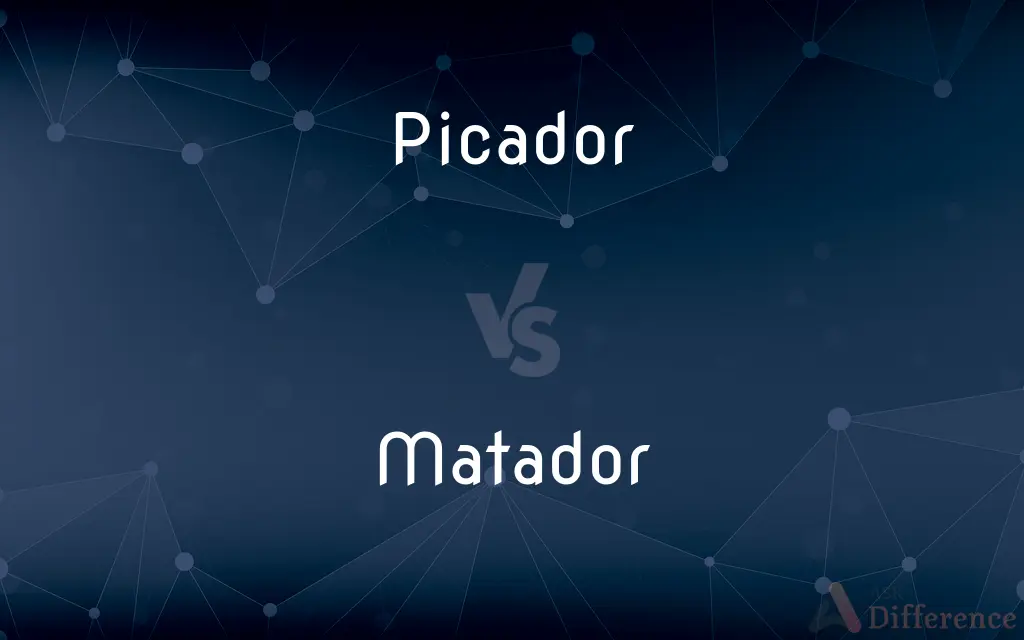Picador vs. Matador — What's the Difference?
By Fiza Rafique & Urooj Arif — Updated on March 28, 2024
A picador is a bullfighter who rides on horseback, using a lance to test the bull's strength and to provoke it, while a matador is the principal bullfighter who performs the final act of killing the bull, showcasing skill and bravery.

Difference Between Picador and Matador
Table of Contents
ADVERTISEMENT
Key Differences
The roles of a picador and a matador are distinct within the traditional bullfighting ceremony. The picador enters the ring first, mounted on horseback, and is tasked with assessing the bull's ferocity and weakening its charge by lancing the bull in the muscle. This role is crucial for setting the stage for the bullfighters on foot, as it helps to gauge the bull's behavior and strength. In contrast, the matador is the main performer in a bullfight, responsible for the artful execution of passes with a cape (muleta) and ultimately killing the bull. The matador's performance is a blend of courage, artistry, and precise technique, aimed at demonstrating dominance over the bull.
While the picador's contribution to the bullfight is more functional, aiming to prepare the bull for the matadors by reducing its ability to lift its head, the matador's role is highly ceremonial and artistic. The matador engages the bull in a series of passes, culminating in the estocada, a single thrust of the sword intended to be fatal. This moment is the climax of the event, showcasing the matador's skill and bravery.
The equipment used by each performer also highlights their different functions. The picador carries a lance (vara) and rides a horse protected by thick padding to minimize injury from the bull. The matador, however, is on foot, dressed in a traditional costume (traje de luces) and uses a cape and sword as tools to direct and ultimately dispatch the bull.
The picador and matador work in tandem within the corrida de toros (bullfight), each playing a specific role in the drama and ritual of the event. The picador's early engagement with the bull sets the tone for the encounter, while the matador's performance is the focal point, drawing attention to the human-animal dynamic at the heart of bullfighting.
Both the picador and the matador are integral to the spectacle of bullfighting, representing different aspects of the tradition. The picador's role is grounded in practicality, helping to ensure the safety and success of the matadors, while the matador's role is steeped in the cultural and artistic expression of the sport.
ADVERTISEMENT
Comparison Chart
Role
Tests the bull's strength, weakens it
Performs the final act of killing the bull
Equipment
Lance (vara), horse with protective padding
Cape (muleta), sword
Objective
Prepare the bull for the matadors
Demonstrate skill and bravery, kill the bull
Position
Mounted on horseback
On foot
Performance
Functional, early in the bullfight
Artistic, ceremonial, climax of the bullfight
Compare with Definitions
Picador
A bullfighter who rides a horse and uses a lance to test and weaken the bull.
The picador skillfully lanced the bull, preparing it for the matador.
Matador
Uses a cape and sword in their performance.
The matador's precise movements with the cape captivated everyone.
Picador
Equipped with a lance for their task.
Armed with his vara, the picador approached the bull cautiously.
Matador
Uses skill and artistry to engage the bull.
With grace, the matador executed a series of elegant passes.
Picador
Rides a heavily padded horse to protect against the bull.
The picador's horse, covered in protective armor, remained calm.
Matador
The principal bullfighter who kills the bull.
The matador stood ready for the final act, sword in hand.
Picador
Focuses on reducing the bull's ability to lift its head.
The crowd watched as the picador aimed to diminish the bull's strength.
Matador
Responsible for the climax of the bullfight.
The audience held its breath as the matador prepared the estocada.
Picador
First to engage the bull in the arena.
The picador entered the ring, marking the beginning of the bullfight.
Matador
Dressed in a traditional costume, the traje de luces.
Dazzling in the sunlight, the matador's suit sparkled.
Picador
A picador (Spanish pronunciation: [pikaˈðoɾ]; pl. picadores) is one of the pair of horse-mounted bullfighters in a Spanish-style bullfight that jab the bull with a lance.
Matador
A bullfighter who performs the final passes and kills the bull.
Picador
A horseman in a bullfight who lances the bull's neck muscles so that it will tend to keep its head low for the later stages of the fight.
Matador
(Games) One of the highest trumps in certain card games.
Picador
(bullfighting) A lancer mounted on horseback who assists a matador.
I saw the picador lance the bull.
Matador
(bullfighting) The person whose aim is to kill the bull in a bullfight.
Picador
A horseman armed with a lance, who in a bullfight receives the first attack of the bull, and excites him by picking him without attempting to kill him.
Matador
(uncountable) A certain game of dominoes in which four dominoes (the 4-3, 5-2, 6-1, and double blank), called matadors, may be played at any time in any way.
Picador
The horseman who pricks the bull with a lance early in the bullfight to goad the bull and to make it keep its head low
Matador
(card games) The jack of clubs, or any other trump held in sequence with it, in the game of skat.
Matador
(card games) One of the three chief cards in ombre and quadrille.
Matador
The killer; the man appointed to kill the bull in bullfights; a bullfighter; a toreador.
Matador
In the game of quadrille or omber, the three principal trumps, the ace of spades being the first, the ace of clubs the third, and the second being the deuce of a black trump or the seven of a red one.
When Lady Tricksey played a four,You took it with a matadore.
Matador
The jack of clubs, or any other trump held in sequence with it, whether by the player or by his adversaries.
Matador
A certain game of dominoes in which four dominoes (the 4-3, 5-2, 6-1, and double blank), called matadors, may be played at any time in any way.
Matador
The principal bullfighter who is appointed to make the final passes and kill the bull
Common Curiosities
Why does a picador ride a horse?
The picador uses the horse to approach the bull safely and to use the lance effectively.
What happens if the matador fails to kill the bull?
If the matador cannot kill the bull, an alternative procedure is followed, potentially involving other assistants to ensure the bullfight concludes.
What is the main difference between a picador and a matador?
The picador weakens the bull from horseback using a lance, while the matador, on foot, performs the final act of killing the bull.
Can a matador also be a picador?
While both are skilled bullfighters, their roles and equipment differ significantly, making them specialized positions.
Is the role of the picador controversial?
Yes, the use of a picador in bullfighting is among the aspects criticized by animal rights activists due to the stress and harm it causes to the bull.
How is the horse protected during the bullfight?
The horse worn by the picador is equipped with thick padding to minimize the risk of injury from the bull.
What training is required for a picador?
Picadors undergo specialized training in horsemanship and lance use, focusing on the tactical aspects of engaging the bull.
Do picadors participate in the final act of the bullfight?
No, the picador's role concludes once they have tested and weakened the bull; the final act is reserved for the matador.
How does the audience perceive the role of the picador?
The picador's role is appreciated for its contribution to the bullfight's dynamics, though it is less glamorous than that of the matador.
What skills are required to be a successful matador?
A matador needs agility, precision, bravery, and an understanding of bull behavior to successfully engage and kill the bull.
How does the crowd show their appreciation for the matador?
The crowd can award ears, tails, or hooves of the bull as trophies, depending on the matador's performance's perceived skill and bravery.
How do picadors and matadors prepare for a bullfight?
Preparation involves physical training, studying bull behavior, and mental conditioning to face the dangers of the arena.
Has the role of the picador evolved over time?
Yes, both the equipment and the techniques used by picadors have been refined to align with changing regulations and societal perspectives on bullfighting.
What happens during a bullfight if the bull does not engage with the picador?
Alternate tactics may be used to ensure the bull engages with the picador, as this interaction is crucial for the bullfight's progression.
What is the significance of the matador's costume?
The matador's costume, or traje de luces, is rich in tradition and symbolizes the honor and risk involved in the bullfight.
Share Your Discovery

Previous Comparison
Purine vs. Pyrimidine
Next Comparison
Guidance vs. SupportAuthor Spotlight
Written by
Fiza RafiqueFiza Rafique is a skilled content writer at AskDifference.com, where she meticulously refines and enhances written pieces. Drawing from her vast editorial expertise, Fiza ensures clarity, accuracy, and precision in every article. Passionate about language, she continually seeks to elevate the quality of content for readers worldwide.
Co-written by
Urooj ArifUrooj is a skilled content writer at Ask Difference, known for her exceptional ability to simplify complex topics into engaging and informative content. With a passion for research and a flair for clear, concise writing, she consistently delivers articles that resonate with our diverse audience.
















































